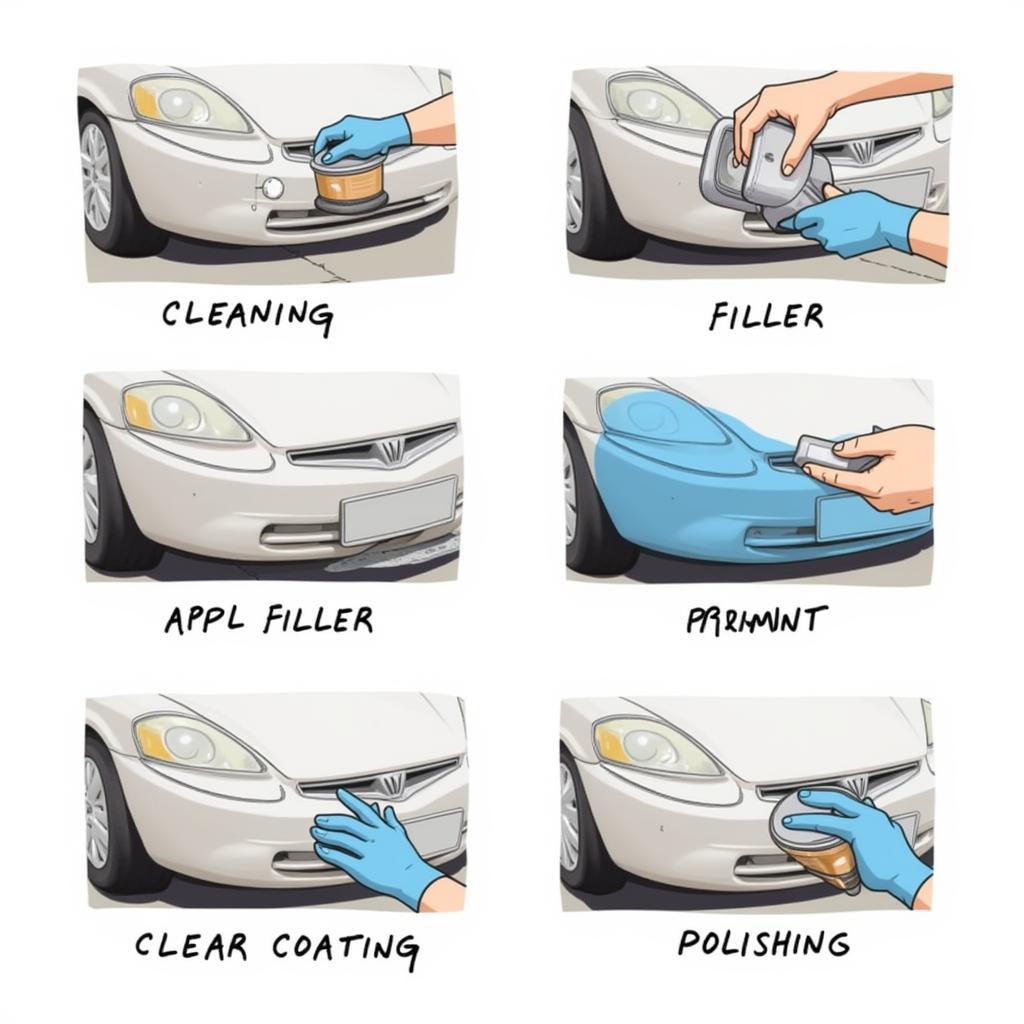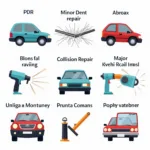Car paint plastic panel repair is often needed after minor accidents or general wear and tear. Understanding the process and options available can save you time and money. This guide will explore everything you need to know about repairing those pesky scratches and dents on your car’s plastic panels.
Repairing plastic car panels requires a different approach than metal panels. Plastic is more flexible and prone to cracking, demanding specific repair techniques and products. We’ll cover everything from DIY fixes for minor scratches to professional repairs for more significant damage. Knowing the difference can help you choose the most cost-effective and aesthetically pleasing solution. Want to know how much a typical repair might cost? Check out our guide on cost to repair car paint.
Understanding Car Paint Plastic Panel Damage
Types of Plastic Panel Damage
Plastic panels can suffer from various types of damage, including scratches, dents, cracks, and fading. Each type requires a specific repair approach. Superficial scratches often respond well to DIY solutions like polishing compounds, while deeper damage may require professional attention.
- Light Scratches: These are often just on the clear coat and can be buffed out.
- Deep Scratches: These penetrate the paint and may require filling and repainting.
- Dents: Depending on the severity, these might be repairable with heat or require filler.
- Cracks: These often require patching or panel replacement.
- Fading: UV exposure can cause the paint to fade, requiring repainting or specialized treatments.
Knowing how long a repair might take can help you plan. For information on repair times, see our article on how long does car paint repair take.
DIY Car Paint Plastic Panel Repair
Minor scratches and scuffs can often be addressed at home with the right tools and techniques. This can save you a significant amount of money compared to professional repairs.
Steps for DIY Repair
- Clean the Area: Thoroughly clean the damaged area with soap and water, then dry it completely.
- Assess the Damage: Determine the depth and severity of the scratch.
- Sanding (if needed): For deeper scratches, lightly sand the area with fine-grit sandpaper.
- Apply Plastic Filler (if needed): If there are dents or deep scratches, apply plastic filler and allow it to dry.
- Sanding and Priming (if needed): Sand the filler smooth and apply primer before painting.
- Painting: Apply several thin coats of matching car paint, allowing each coat to dry before applying the next.
- Clear Coat: Apply a clear coat to protect the paint and give it a glossy finish.
- Polishing: After the clear coat dries, polish the area to blend it seamlessly with the surrounding paint.
Looking for more information on scratch repair costs? Our guide on repair scratch car paint cost can provide you with valuable insights.
 DIY Car Paint Plastic Panel Repair Steps
DIY Car Paint Plastic Panel Repair Steps
Professional Car Paint Plastic Panel Repair
For more extensive damage or if you’re not comfortable with DIY repairs, seeking professional help is the best option. Professionals have the expertise and specialized tools to ensure a high-quality repair.
Benefits of Professional Repair
- Expertise: Professionals have the experience and knowledge to handle complex repairs.
- Color Matching: They can precisely match the paint color to your car.
- Durable Repairs: Professional repairs are typically more durable and long-lasting.
- Warranty: Many shops offer warranties on their work.
“Choosing the right repair method is crucial. For minor damage, a DIY approach might be sufficient, but for significant damage or if you want a perfect finish, professional repair is the way to go.” – John Smith, Automotive Repair Specialist
Need to know more about the combined cost of scratch and paint repair? Visit our page on car scratch and paint repair cost for a detailed breakdown.
Conclusion
Car paint plastic panel repair can range from simple DIY fixes to more complex professional repairs. Understanding the different types of damage, repair options, and associated costs will help you make informed decisions and keep your car looking its best. Remember, addressing damage promptly can prevent further deterioration and maintain the value of your vehicle. Don’t forget to check our guide on how much does paint repair cost on a car for more detailed pricing information.
FAQ
- Can I repair a cracked plastic bumper myself? Yes, minor cracks can be repaired with epoxy or plastic welding kits, but larger cracks often require professional repair or replacement.
- How do I match the paint color for my car? Auto parts stores can usually mix paint to match your car’s color code, which is typically found on a sticker inside the driver’s side door jamb.
- How long does plastic filler take to dry? Drying times vary depending on the product, but it typically takes between 30 minutes to a few hours.
- What kind of sandpaper should I use for plastic? Use fine-grit sandpaper, such as 220-grit or higher, to avoid further damaging the plastic.
- How can I prevent plastic panel fading? Regularly waxing your car and parking it in shaded areas can help prevent fading caused by UV exposure.
- Is it necessary to use a primer on plastic? While not always required, using a primer specifically designed for plastic can improve paint adhesion and durability.
- How much does professional car paint plastic panel repair cost? The cost varies depending on the extent of the damage, but expect to pay anywhere from a few hundred dollars to over a thousand for more significant repairs.
Need help with car paint plastic panel repair? Contact us via WhatsApp: +1(641)206-8880, or Email: [email protected]. Our 24/7 customer service team is ready to assist you.

